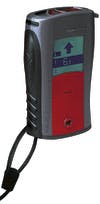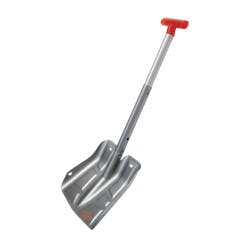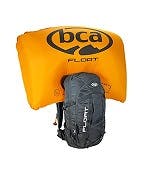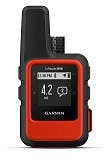Gear plays a critical role in avalanche safety. It’s simple: if you’re in avalanche terrain, you must carry the right gear and know how to use it. Everyone in your group needs an avalanche transceiver, a shovel, and a probe. One or two of the three isn’t good enough—you’ve got to have them all.
The best way to stay safe is to make good decisions, but if something goes wrong, avalanche safety gear is critically important to a successful rescue. It goes both ways: you’ve got to carry the gear so you can rescue others, and all your riding companions must do so as well so that they can effectively rescue you if necessary.
When a person is buried in an avalanche, minutes can make the difference between life and death. You can waste a lot of time if you can’t use your gear efficiently. Make sure to take a training course, and practice, practice, practice.
Avalanche Transceiver

- Credit
- Barryvox
Avalanche transceivers are small electronic devices worn close to the body. When travelling, everyone’s transceiver sends out a radio signal. In the event of an avalanche, those not buried switch their transceiver to search mode and follow the signal toward a buried person.
Three-antennae digital transceivers with a visual display and audio display set the standard for ease of use, speed, and accuracy. Features and functions may also include a marking function for locating multiple burials, or transmission of “vital data” to support triage.
Single-antenna (analog) transceivers are considered obsolete. Need convincing? Three antennae digital transceivers generally won’t find single antenna transceivers as well as digital units. That means if two people are buried close together, the one with the digital transceiver is likely to be found first. Signal overlap can also be a significantly bigger issue with old transceivers in a multi-burial scenario.
Remember, people who practice post the fastest transceiver search times. Whichever avalanche transceiver you choose, practice before, during, and after the season.
Please note that many electronic devices and even the magnets in your jacket snaps can cause interference with transceivers. Please see Transceiver Interference below for more information.
Probe

Transceivers get you close to buried victims, and probes help you find them. Avalanche probes snap together like tent poles. An assembled probe inserted in the snow in a systematic pattern lets searchers physically pinpoint someone under the snow so that time isn’t wasted digging.
Probes vary in length, stiffness and materials, which translate into difference in weight, durability, and cost. Smaller diameter probes may be more likely to bend or deflect. The locking mechanism and line are important: you want a reliable, durable mechanism and a cable that doesn’t stretch (to prevent wear, tear and breaking). 240 cm is the shortest standard length, and works fine where snowpacks are shallower, and for most rescues. If you recreate in deeper snowpack areas or use it for snowpack observations, consider a 320 cm probe.
Shovel

An avalanche shovel is a specialized shovel which has a handle that can be removed from the blade, making it easy to store in a backpack. Remember, not all shovels are created equal. It must fit into your pack, but within reason bigger is better. Avoid plastic or flimsy shovels, as they can break in cold temperatures or while digging in hard avalanche debris. An extendable shaft helps make digging easier so you don't fatigue as quickly. Practice effective shovelling techniques—it can make the difference between life and death.
Transceiver Interference
We have had an incident reported to us where a person’s transceiver was made useless because of the small magnets in their jacket’s closure system. Several types of transceivers have a magnetic on/off or off/send/search switch. If you have a magnet close to these transceivers, they can randomly turn the unit off, or to search, or to send. Some transceivers also contain an electronic compass that can be highly sensitive to magnets and electromagnetic fields, especially during a search.
Magnets are just one of many items that can interfere with an avalanche transceiver’s signal. We need to be careful of all metallic objects and electronic devices. Research tells us to keep these items 20 cm away from transceivers in transmit mode, and 50 cm away when in search mode.
A partial list includes:
- Metallic foil (such as wrapping on food, candy or cigarettes)
- Cell phones
- Cameras
- MP3 music players
- Heated gloves
- Headlamps
A quick search for “transceiver interference” will give you some good articles. Also check out the online collection of papers presented at International Snow Science Workshops (ISSW). Montana State University provides a free searchable database of this research. You can find that collection here.
Recommended Gear
Avalanche Airbag Packs

Avalanche airbags (or balloon packs) can help reduce the severity of the effects of being caught in an avalanche by reducing burial depth (or even preventing burial), and/or facilitating rapid localization. They also help with visibility and may provide some degree of trauma protection.
It's crucial to remember that an airbag is not a silver bullet. You need to know how to set it up and deploy it properly. Even if deployed properly, you can still be buried with an airbag pack on if you are swept into a depression where snow can slide on top of you. Failure to deploy the bag, failure to set up the equipment properly (e.g. using the crotch strap), and failure to recognize the seriousness of terrain traps have all occurred for airbag users and resulted in death.
Remember, even if you have an airbag pack, you must also carry a transceiver, shovel, and probe and know how to use them.
Emergency Communication

Although not a substitute for companion rescue or self-sufficiency, emergency communication is valuable. Cell phones may work close to ski areas, cities, and along highway corridors. Satellite phones work in most remote locales. VHF radios are an option, but require a license.
Another option is a portable transmitter that can send a signal via satellite. Personal locator beacons are used to send out a personalized emergency distress signal on an internationally-recognized military satellite network. Satellite messengers, such as InReach or SPOT, are GPS-based devices that rely on a commercial satellite network. These devices allow you to communicate short text messages and/or location coordinates to friends and family or, in an emergency, send calls for help. For a good explanation on the differences between satellite messengers and personal locator beacons, check this page.
No matter what you use, it’s important to plan ahead. Make sure whoever you have selected to receive an emergency message knows what to do. If you're able to call for help directly, have the phone number of the agency you want. If you don’t have that, dial 911 and ask for RCMP to initiate a SAR response.
Also, recognize that these electronic devices come with electromagnetic interference. It’s critically important to keep them separated from your transceiver when transmitting, and even more important when searching with a transceiver (generally 50cm).
